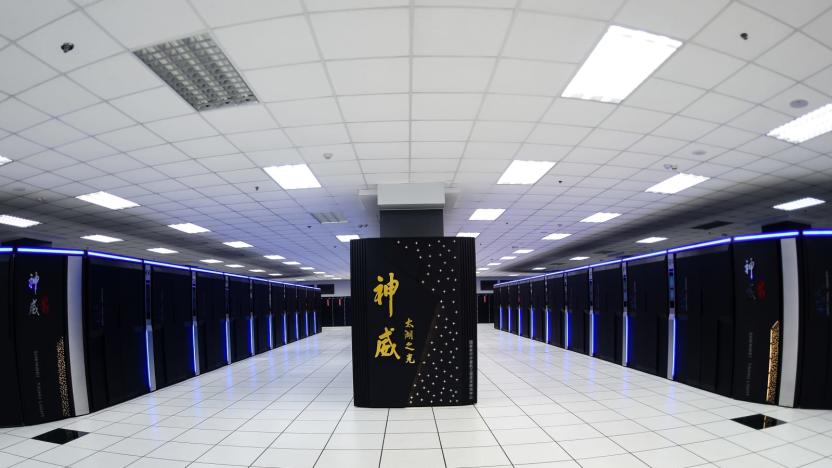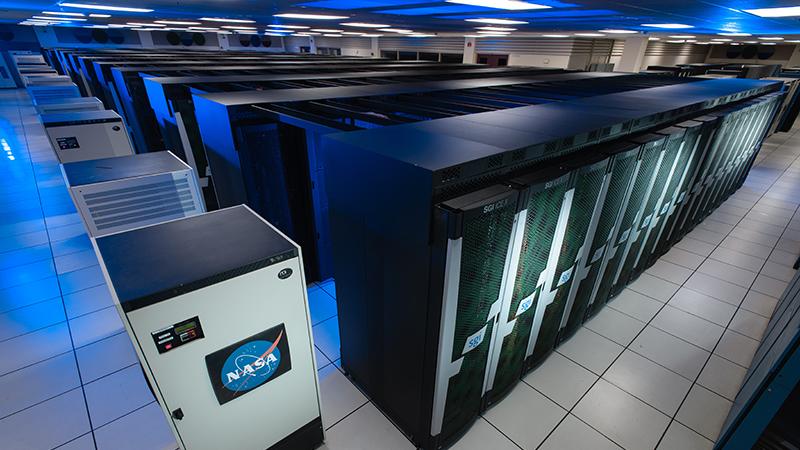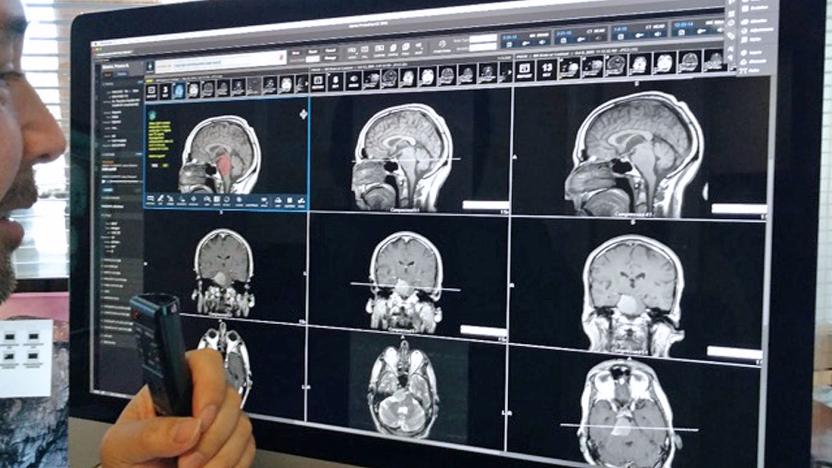supercomputer
Latest

NASA's new moon-landing supercomputer is more powerful and more eco-friendly
NASA has officially opened its new supercomputer, Aitken, at the Ames Research Center in Silicon Valley. It uses a modular design which requires less electricity and power than traditional facilities and and it will allow researchers to run complex simulations more quickly.

Cray is building a supercomputer to manage the US' nuclear stockpile
Supercomputers are used for everything from mapping weather patterns to developing medicine –- now, they're looking after the nation's nuclear stockpile. The US Department of Energy (DOE) and National Nuclear Security Administration (NNSA) have announced they've signed a contract with Cray Computing for the NNSA's first exascale supercomputer, "El Capitan."

Supercomputer creates millions of virtual universes
How do you understand the development of galaxies when even the younger examples are frequently billions of years old? Simulate as many universes as you can, apparently. Researchers at the University of Arizona have used the school's Ocelote supercomputer as a "UniverseMachine" that generates millions of mini universes to see how well they line up with the real cosmos. Rather than try to portray every nuance of the whole universe (even a single fully modeled galaxy would require far too much computing power), the team devised a system that had just enough resolution to scale from supernovae to a "sizeable chunk" of observed space. Each virtual universe had a different set of rules, and it was largely a matter of seeing which simulations lined up the closest with real data.

China's supercomputers are the latest target in US trade war
The US and China have been locked in a race for the world's most powerful supercomputer. China was in the lead with its Sunway TaihuLight, which has a 93 petaflop capacity. But the US surpassed that last year, when it released the Summit, which can run at 200 petaflops -- or 200 quadrillion calculations per second. Now, the US is using export restrictions in an attempt to thwart China's supercomputing efforts.

AMD and Cray are building the 'world's most powerful supercomputer'
The US may be set to hang onto the crown of having the world's most powerful supercomputer for some time. Cray Computing and AMD are building an exascale machine with the Oak Ridge National Laboratory. The system is set to debut in 2021, the same year Cray and Intel are scheduled to deliver the Aurora exascale supercomputer to the Argonne National Laboratory.

Every shot from the Masters will be posted online within five minutes
Golf fans who are planning to watch the Masters this weekend will have yet more ways to check out the action. For the first time at a golf tournament, practically every one of the more than 20,000 shots from the first major of the year will be available to view on the Masters website and app within five minutes of a player striking the ball.

Intel will build the first exascale supercomputer in the US
The US might currently have the world's most powerful supercomputer, but it isn't resting on its laurels. An international race is on to build exascale supercomputers (systems capable of a quintillion calculations per second) and today, Secretary of Energy Rick Perry announced Intel and sub-contractor Cray Computing will construct the first such system in the US. The supercomputer will be called Aurora, and Intel is aiming to deliver it to the Department of Energy's Argonne National Laboratory in the Chicago area in 2021.

IBM is turning to your smartphone to improve weather forecasts
IBM and its subsidiary The Weather Company are working on a new weather forecasting system, one that they say will boost forecast accuracy quite a bit. It's called the Global High-Resolution Atmospheric Forecasting System, or GRAF, and it will pull data from weather stations, aircraft sensors and smartphone pressure sensors -- a massive amount of information that will be analyzed by the IBM technology that powers the US Department of Energy's powerful Summit and Sierra supercomputers.

HPE supercomputer will help simulate mammalian brains
Scientists are about to get a serious assist in their quest to simulate brains. HPE has deployed Blue Brain 5, a supercomputer dedicated to simulations and reconstructions of mammalian brains as part of the École Polytechnique Fédérale de Lausanne's Blue Brain Project. The system is based on HPE's existing SGI 8600 (above) and packs a hefty 372 compute nodes between its Xeon Gold, Xeon Phi and Tesla V100 processors, not to mention a whopping 94TB of memory. More importantly, it's flexible -- Blue Brain 5 has four configurations to prioritize different computing tasks, and it can host subsystems geared toward relevant tasks (including deep learning and visualization) while operating as a cohesive whole.

The US again has the world's most powerful supercomputer
The Department of Energy pulled back the curtain on the world's most powerful supercomputer Friday. When Summit is operating at max capacity, it can run at 200 petaflops -- that's 200 quadrillion calculations per second. That smokes the previous record holder, China's Sunway TaihuLight (which has a 93 petaflop capacity). Summit is also about seven times faster than Titan, the previous US record holder which is housed at the same Oak Ridge National Lab in Tennessee. For perspective, in one hour, Summit can solve a problem that it would take a desktop computer 30 years to crack.

Japan's latest supercomputer is dedicated to nuclear fusion
This year, Japan will deploy a Cray XC50 that will be the world's most powerful supercomputer in the field of advanced nuclear fusion research. It will be installed at the National Institutes for Quantum and Radiological Science (QST) and used for local nuclear fusion science and to support ITER, the massive multinational fusion project scheduled to come online in 2035.

Chinese scientists created the largest virtual universe
A team of Chinese scientists put the world's faster supercomputer to the test by using it to create the biggest virtual universe. They're calling it a "warm-up exercise" for the machine called Sunway TaihuLight, which used 10 million CPU cores to crunch numbers for the simulation. According to South China Morning Post (SCMP), an English-language newspaper based in Hong Kong, Sunway's universe was five times bigger than the simulation ran by astrophysicists from the University of Zurich back in June. The downside was that it only lasted for an hour, whereas the Swiss simulation lasted 80.

The Air Force and IBM are building an AI supercomputer
Supercomputers today are capable of performing incredible feats, from accurately predicting the weather to uncovering insights into climate change, but they still by and large rely on brute processor power to accomplish their tasks. That's where this new partnership between the US Air Force and IBM comes in. They're teaming up to build the world's first supercomputer that behaves like a natural brain.

IBM supercomputers will power global weather forecasts
IBM's supercomputers might soon power the weather-predicting systems of tomorrow. Through its subsidiary The Weather Company, the computing titan has partnered with the University Corporation for Academic Research (UCAR) and the National Center for Atmospheric Research (NCAR) to move beyond today's regional-scale forecasting to anticipate weather at the local level...and aspire to introduce the first model that covers the whole globe.

NASA needs your help to turbocharge its supercomputer
It's not exactly a secret that parts of the US government run on painfully antiquated hardware that can cost billions to maintain. Decades-old code might do the trick for generating a tax return, but it isn't exactly ideal when you're a NASA research lab tasked with modeling complex fluid dynamics and designing the next generation of experimental aircraft. That's why the space agency recently announced the High Performance Fast Computing Challenge (HPFCC) which hopes to find a few talented coders who can make the agency's design software run ten to 10,000 times faster on its Pleiades supercomputer without sacrificing accuracy.

IBM's Watson looked into my soul and 'drew' my portrait
Since its introduction to the world in 2009, IBM's Watson supercomputer has been crushing humans in Jeopardy, helping chefs make food with unconventional recipes and even offering tech support. But what happens when the artificial intelligence machine puts its own spin on a photo booth? To find out, I checked out IBM's "Art with Watson: Hidden Portraits," an exhibit that's being displayed in New York City until May 7th. The gallery features portraits of historic personalities like Marie Curie and Nikola Tesla, which Watson helped artists create by feeding them data collected using its natural language and personality insights APIs.

Supercomputer simulation looks inside of 2011's deadliest tornado
In may of 2011, a sequence of tornadoes roared across the midwestern United States. The incident became a focal point for scientists eager to learn what it is about supercell storms that allow them to form such devastating tornados. It's an important field of study, but a challenging one -- these storms are so enormous there's simply too much data for typical methods to work through. So, what's a atmospheric scientist to do? Use a supercomputer, of course.

How an AI took down four world-class poker pros
"That was anticlimactic," Jason Les said with a smirk, getting up from his seat. Unlike nearly everyone else in Pittsburgh's Rivers Casino, Les had just played his last few hands against an artificially intelligent opponent on a computer screen. After his fellow players -- Daniel McAulay next to him and Jimmy Chou and Dong Kim in an office upstairs -- eventually did the same, they started to commiserate. The consensus: That AI was one hell of a player.

Libratus, the poker-playing AI, destroyed its four human rivals
The Kenny Rogers classic profoundly states that "you've got to know when to hold 'em, know when to fold 'em," and for the first time, an AI has out-gambled world-class players at heads-up, no-limit Texas Hold'em. Our representatives of humanity -- Jason Les, Dong Kyu Kim, Daniel McAulay and Jimmy Chou -- kept things relatively tight at the outset but a ill-fated shift in strategy wiped out their gains and forced them to chase the AI for the remaining weeks. At the end of day 20 and after 120,000 hands, Libratus claimed victory with daily total of $206,061 in theoretical chips and an overall pile of $1,766,250.

In IBM's future, Watson will be your doctor
IBM is working on a way to make its Watson supercomputer a far more effective medical tool for flesh-and-blood doctors. The company wants to use the platform to analyze medical imaging data to learn what a healthy set of insides looks like. It should then be able to identify when things have gone awry in scan images to direct doctors toward areas of concern. If this data is merged with each patient's medical records, it could mean faster and more effective treatment for serious conditions.













